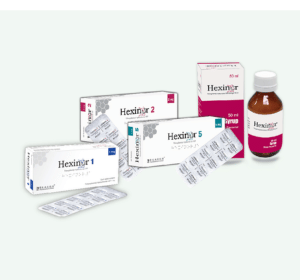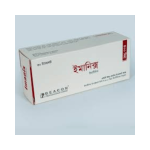Hexinor

Generic Name:Trihexyphenidry
Indications
Hexinor is indicated as an adjunct in the treatment of all forms of parkinsonism (postencephalitic, arteriosclerotic, and idiopathic). It is often useful as adjuvant therapy when treating these forms of Parkinsonism with levodopa. Additionally, it is indicated for the control of extrapyramidal disorders caused by central nervous system drugs such as the dibenzoxazepines, phenothiazines, thioxanthenes, and butyrophenones.
Description
Hexinor exerts a direct inhibitory effect upon the parasympathetic nervous system. It also has a relaxing effect on smooth musculature; exerted both directly upon the muscle tissue itself and indirectly through an inhibitory effect upon the parasympathetic nervous system.
Pharmacology
Trihexyphenidyl is a non-selective muscarinic acetylcholine receptor antagonist but binds with higher affinity to the M1 subtype. In vivo studies have shown that trihexyphenidyl demonstrates higher affinity for central muscarinic receptors located in the cerebral cortex and lower affinity for those located peripherally. Other studies suggest that trihexyphenidyl may modify nicotinic acetylcholine receptor neurotransmission, leading indirectly to enhanced dopamine release in the striatum. Although the anticholinergic has proven to be useful in the treatment of symptoms associated with Parkinson’s disease or other movement disorders, its mechanism of action has yet to be fully elucidated.
Dosage & Administration
Dosage should be individualized. The initial dose should be low and then increased gradually, especially in patients over 60 years of age. Whether Trihexyphenidyl may best be given before or after meals should be determined by the way the patient reacts. Postencephalitic patients, who are usually more prone to excessive salivation, may prefer to take it after meals and may, in addition, require small amounts of atropine which, under such circumstances, is sometimes an effective adjuvant. If Trihexyphenidyl tends to dry the mouth excessively, it may be better to take it before meals, unless it causes nausea. If taken after meals, the thirst sometimes induced can be allayed by mint candies, chewing gum or water. Abrupt withdrawal of treatment for Parkinsonism may result in acute exacerbation of Parkinsonism symptoms; therefore, abrupt withdrawal should be avoided. Abrupt withdrawal of treatment may result in neuroleptic malignant syndrome (NMS).
Idiopathic Parkinsonism: As initial therapy for parkinsonism, 1 mg of Trihexyphenidyl form may be administered the first day. The dose may then be increased by 2 mg increments at intervals of three to five days, until a total of 6 to 10 mg is given daily. The total daily dose will depend upon what is found to be the optimal level. Many patients derive maximum benefit from this daily total of 6 to 10 mg, but some patients, chiefly those in the postencephalitic group, may require a total daily dose of 12 to 15 mg.
Drug-Induced Parkinsonism: The size and frequency of the Trihexyphenidyl dose needed to control extrapyramidal reactions to commonly employed tranquilizers, notably the phenothiazines, thioxanthenes, and butyrophenones, must be determined empirically. The total daily dosage usually ranges between 5 and 15 mg although, in some cases, these reactions have been satisfactorily controlled with as little as 1 mg daily. It may be advisable to commence therapy with a single 1mg dose. If the extrapyramidal manifestations are not controlled in a few hours, the subsequent doses may be progressively increased until satisfactory control is achieved. Satisfactory control may sometimes be more rapidly achieved by temporarily reducing the dosage of the tranquilizer when instituting Trihexyphenidyl therapy and then adjusting the dosage of both drugs until the desired ataractic effect is retained without onset of extrapyramidal reactions. It is sometimes possible to maintain the patient on a reduced Trihexyphenidyl dosage after the reactions have remained under control for several days. Instances have been reported in which these reactions have remained in remission for long periods after Trihexyphenidyl therapy was discontinued.
Concomitant use with Levodopa: When Trihexyphenidyl is used concomitantly with levodopa, the usual dose of each may need to be reduced. Careful adjustment is necessary, depending on side effects and degree of symptom control. Trihexyphenidyl dosage of 3 to 6mg daily, in divided doses, is usually adequate. Concomitant use with other Parasympathetic Inhibitors: Trihexyphenidyl may be substituted, in whole or in part, for other parasympathetic inhibitors. The usual technique is partial substitution initially, with progressive reduction in the other medication as the dose of Trihexyphenidyl is increased.
The total daily intake of Trihexyphenidyl tablet is tolerated best if divided into 3 doses and taken at mealtimes. High doses (>10 mg daily) may be divided into 4 parts, with 3 doses administered at mealtimes and the fourth at bedtime.
Use in children: Safety and effectiveness in pediatric patients have not been established.



